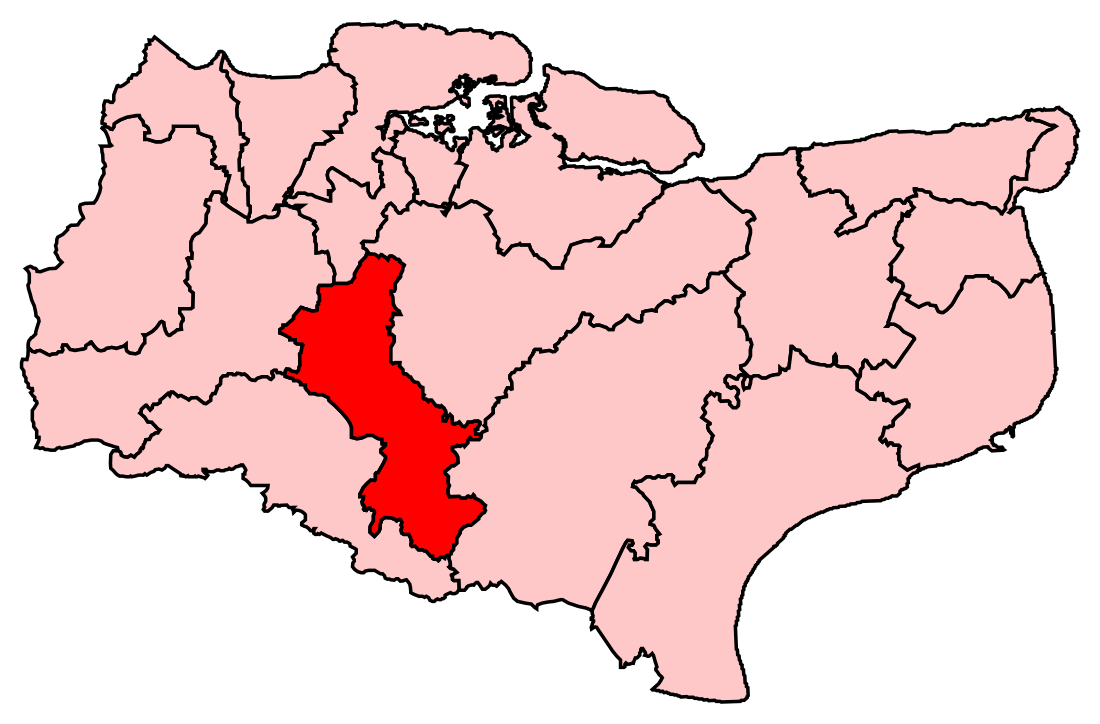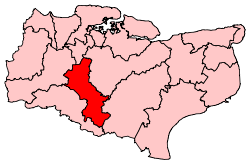Top Qs
Timeline
Chat
Perspective
Maidstone and The Weald (UK Parliament constituency)
Parliamentary constituency in the United Kingdom, 1997-2024 From Wikipedia, the free encyclopedia
Remove ads
Maidstone and The Weald was a constituency[n 1] in Kent represented in the House of Commons of the UK Parliament. From the 2010 general election it was represented by Helen Grant of the Conservative Party. She succeeded fellow party member Ann Widdecombe, who had held the seat since it was created for the 1997 general election.
Remove ads
Further to the completion of the 2023 Periodic Review of Westminster constituencies, the seat was abolished. Subject to boundary changes - losing southern, rural areas ("The Weald") to the newly created constituency of Weald of Kent, and gaining parts of the Borough of Tonbridge and Malling, including the town of West Malling, it will be reformed as Maidstone and Malling, to be first contested in the 2024 general election.[2]
Remove ads
Boundaries
1997–2010: The Borough of Maidstone wards of Allington, Barming, Boughton Monchelsea, Bridge, Coxheath, East, Farleigh, Heath, High Street, Loose, Marden, North, South, Staplehurst, Yalding; and the Borough of Tunbridge Wells wards of Benenden, Cranbrook, Frittenden and Sissinghurst, Hawkhurst, Sandhurst.
2010–2024: The Borough of Maidstone wards of Allington, Barming, Bridge, Coxheath and Hunton, East, Fant, Heath, High Street, Loose, Marden and Yalding, North, South, Staplehurst; and the Borough of Tunbridge Wells wards of Benenden and Cranbrook, Frittenden and Sissinghurst.
The largest settlement was the central county town of Maidstone in Kent in southeast England, with smaller settlements spread throughout agriculture-rich Maidstone borough and partly wooded Tunbridge Wells borough.
Remove ads
History
The constituency was created for the 1997 general election, after the previous Maidstone constituency was split in two: its southeast wards of Shepway and Park Wood of the town itself and the rural wards east of the town joined Faversham in the new Faversham and Mid Kent constituency. The remaining two-thirds of the electorate in west-central Maidstone were reunited with the town wards that had been lost in 1983 to Mid Kent (which was abolished), as well as joined by a rural part of the Weald to the south of the town, previously in the Tunbridge Wells constituency.
- History of members
The Member of Parliament (MP) for the seat from its creation in 1997 was Ann Widdecombe of the Conservative Party. Widdecombe was the MP for the former seat of Maidstone (1987–1997); she served as a Home Office Minister of State in the government of John Major from 1995 to 1997 and later as Shadow Home Secretary from 1999 to 2001. She stood down at the 2010 general election and was succeeded by Helen Grant, also a member of the Conservative Party.
Remove ads
Constituency profile
Most of the electorate live in urban Maidstone, which has some light industry but whose economy is increasingly dominated by the service sector (including care, hospitality and insurance). The south of the constituency is rural with significant orchards and market gardens. Many residents commute daily to London. To summarise this is an urban-rural seat in a prosperous part of Kent.[3]
Members of Parliament
Elections
Elections in the 2010s
Elections in the 2000s
Elections in the 1990s
Remove ads
See also
Notes
- A county constituency (for the purposes of election expenses and type of returning officer)
References
Sources
External links
Wikiwand - on
Seamless Wikipedia browsing. On steroids.
Remove ads



